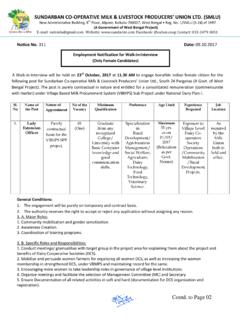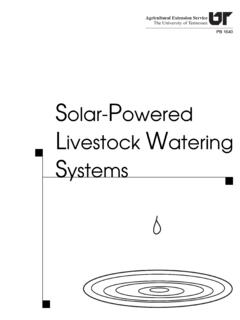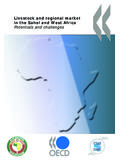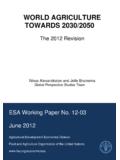Transcription of Understanding and integrating gender issues into livestock ...
1 Iii ACKNOWLEDGEMENT 1 INTRODUCTION 5 Understanding gender issues IN livestock PROJECTS AND PROGRAMMES 5 gender AND LIVESTOCK11 gender , SMALL livestock AND DAIRY FARMING 11 Small Ruminants Sub-Sector15 Poultry Sub-Sector17 Dairy Farming 21 integrating gender issues IN livestock PROJECTS AND PROGRAMMES 21 gender , SMALL livestock AND DAIRY FARMING ChECKLIST22 Stakeholder Analysis/ project Identification and Design 24 project Appraisal and Implementation 26 Reporting, Monitoring and Evaluation29 gender ANALYSIS TIPS AND TOOLS 39 LIST OF SUGGESTED TOOLS AND RESOURCES40 REFERENCES AND RESOURCESA checklist for practitionersUNDERSTANDING and integrating gender issues into livestock PROJECTS and PROGRAMMES iii ACKNOWLEDGEMENT 1 INTRODUCTION 5 Understanding gender issues IN livestock PROJECTS AND PROGRAMMES 5 gender AND LIVESTOCK11 gender , SMALL livestock AND DAIRY FARMING 11 Small Ruminants Sub-Sector15 Poultry Sub-Sector17 Dairy Farming 21 integrating gender issues IN livestock PROJECTS AND PROGRAMMES 21 gender , SMALL livestock AND DAIRY FARMING ChECKLIST22 Stakeholder Analysis/ project Identification and Design 24 project Appraisal and Implementation 26 Reporting, Monitoring and Evaluation29 gender ANALYSIS TIPS AND TOOLS 39 LIST OF SUGGESTED TOOLS AND RESOURCES40 REFERENCES AND RESOURCESThe designations employed and the presentation of material in this information product do not imply the expression of any opinion whatsoever on the part of the Food and Agriculture Organization of the United Nations (FAO) concerning the legal or development status of any country, territory, city or area or of its authorities, or concerning the delimitation of its frontiers or boundaries.
2 The mention of specific companies or products of manufacturers, whether or not these have been patented, does not imply that these have been endorsed or recommended by FAO in preference to others of a similar nature that are not mentioned. The views expressed in this information product are those of the author(s) and do not necessarily reflect the views or policies of 978-92-5-107513-5 (print)E-ISBN 978-92-5-107514-2 (PDF) FAO 2013 FAO encourages the use, reproduction and dissemination of material in this information product. Except where otherwise indicated, material may be copied, downloaded and printed for private study, research and teaching purposes, or for use in non-commercial products or services, provided that appropriate acknowledgement of FAO as the source and copyright holder is given and that FAO s endorsement of users views, products or services is not implied in any requests for translation and adaptation rights, and for resale and other commercial use rights should be made via or addressed to information products are available on the FAO website ( )
3 And can be purchased through iii ACKNOWLEDGEMENT 1 INTRODUCTION 5 Understanding gender issues IN livestock PROJECTS AND PROGRAMMES 5 gender AND LIVESTOCK11 gender , SMALL livestock AND DAIRY FARMING 11 Small Ruminants Sub-Sector15 Poultry Sub-Sector17 Dairy Farming 21 integrating gender issues IN livestock PROJECTS AND PROGRAMMES 21 gender , SMALL livestock AND DAIRY FARMING ChECKLIST22 Stakeholder Analysis/ project Identification and Design 24 project Appraisal and Implementation 26 Reporting, Monitoring and Evaluation29 gender ANALYSIS TIPS AND TOOLS 39 LIST OF SUGGESTED TOOLS AND RESOURCES40 REFERENCES AND RESOURCESSECTION 1 SECTION 2contEntSiiiAcKnoWLEDGEMEnt This publication is the product of the collaboration between the Animal Production and Health Division (AGA) and the gender , Equity and Rural Employment Division (ESW). Raffaele Mattioli, Senior Officer from FAO s AGA Division, and Regina Laub, Senior Officer from FAO s ESW Division, supervised the overall process, providing valuable technical inputs to the development of this publication.
4 The lead author, Francesca Distefano, gender and Development Specialist, is responsible for the publication in its present form. We are grateful to all colleagues in FAO AGA and ESW divisions, as well as FAO Sub-Regional Office for Eastern Africa (SFE), the International livestock Research Institute (ILRI), the International Fund for Agricultural Development (IFAD), the Global Alliance for livestock Veterinary Medicines (GALVmed) and representatives of ministries of livestock , agriculture and fisheries from Kenya, Uganda and Tanzania, who have provided valuable comments. Finally, we are grateful to Alexandra Shaw for document revision and editorial comments. 1 IntRoDUctIon In rural societies, where local culture and traditions are still very vibrant, responsibilities and tasks are often assigned to women and men on the basis of traditional gender roles, defined as those behaviours and responsibilities that a society considers appropriate for men, women, boys and girls.
5 These roles change over time, have different characteristics in every local context and are shaped by ideological, religious, cultural, ethnic and economic factors. They are a key determinant of the distribution of resources and responsibilities between men and women (FAO, 2010b).In many cases gender roles are biased and favour certain social constituencies at the expense of others. Rural women, for instance, face serious obstacles more regularly than men, since traditional structures and perceptions tend to prevent them from obtaining the necessary tools to reach their full potential in the agricultural sector. In fact, despite their major involvement in and contribution to livestock management, women tend to have limited access to resources, extension services and less participation in decision making compared to their male counterparts (FAO, 2011a).Recognizing the different roles that women and men play in the agriculture sector is key to identifying the diverse challenges they face and tailoring projects and programmes on their specific needs.
6 Understanding and integrating these diverse roles and specific dynamics into projects and programmes can significantly improve their outcomes and effectiveness (FAO, IFAD, World Bank, 2007; FAO, 2011a).2 Understanding and integrating gender issues INTO livestock PROJECTS and PROGRAMMESU ltimately, this booklet is designed to facilitate gender analysis in projects and programmes in the livestock sector. It identifies the main challenges faced by smallholder farmers, especially women, in small livestock management (particularly poultry and small ruminants) and in dairy farming. These specific livestock subsectors, including all activities related to dairy farming, have been specifically selected for this study because of women s significant contribution and involvement. This booklet is intended to help livestock experts and professionals involved in field projects and interventions to:1. Identify the main constraints faced by women and men in accessing, controlling and managing small livestock and dairy farming;2.
7 Design projects and programmes that address the challenges faced by women and men in access to, control over and management of small livestock and dairy booklet consists of two main sections:The first section provides users with an overview and Understanding of key gender issues in the livestock sector, with a discussion of seven broad categories of challenges often faced by smallholder farmers. Special attention is given to the distinct roles of men and women, as well as to the particular constraints faced by women, in the poultry and small ruminant sub-sectors as well as in dairy farming second section presents two main tools: a gender checklist and a set of tips and gender analysis tools. The checklist is a useful and important tool for practitioners involved in designing, implementing or monitoring livestock programmes and projects, using a gender sensitive approach. It consists of a series of questions on small livestock , dairy farming and gender related issues .
8 The questions featured in the checklist are meant to guide users in identifying and meeting the needs of men and women throughout all stages of the project cycle in livestock interventions, thereby contributing to improved effectiveness and results. The second tool consists of a set of tips and gender analysis tools to help users better capture the social, economic and cultural aspects that influence the dynamics between women and men in small livestock management and dairy farming, which also improves project and programme results. Understanding gender issues IN livestock PROJECTS and PROGRAMMES integrating gender issues IN livestock PROJECTS and PROGRAMMES5 SEctIon 1 Understanding gender issues IN livestock PROJECTS and PROGRAMMES gender and LIVESTOCKO verview of key gender issues in the livestock sectorLivestock is considered a key asset for rural households worldwide and a primary livelihood resource for rural communities: about 752 million of the world s poor keep livestock to produce food, generate cash income, manage risks and build up assets (FAO, 2012a).
9 livestock widens and sustains three major pathways out of poverty: (1) securing the assets of the poor, (2) improving smallholder and pastoral productivity and (3) increasing market participation by the poor (ILRI, 2007). Especially in rural areas, the development of small-scale livestock enterprises must be seen as a key element of any efforts to eradicate extreme poverty and hunger (FAO 2010b).Rural women perform a reproductive role, encompassing child bearing, child rearing and housework. At the same time, they also fulfil a productive role, engaging in paid labour activities outside the house and/or being in charge of a number of tasks related to household farming activities, including livestock management. In some developing countries, they make on average up to 43 percent of the agricultural labour force and contribute substantially to the livestock management (FAO, 2011). 6 Understanding and integrating gender issues INTO livestock PROJECTS and PROGRAMMESIn rural livestock -based economies, rural women comprise two-thirds (approximately 400 million people) of low-income livestock keepers.
10 In particular, activities related to small livestock production (poultry, sheep, goats), milking and processing of milk, are carried out mainly by women and, to some extent, by children (Okali, 1998; Thornton, 2001; FAO, 2011a).Women and men experience different challenges when accessing, managing and controlling livestock assets. Despite their important contribution and role in livestock management, women often face greater constraints than men in accessing natural resources, extension services, marketing opportunities and financial services as well as in exercising their decision-making powers. These constraints often prevent women from reaching their full potential within the agricultural sector, including livestock , and therefore compromise the achievement of overall household food security and nutrition. Since women usually manage household meals, they have a primary role with regard to the nutritional status of the household, especially the children.















